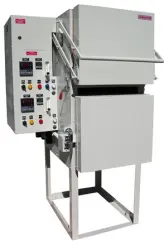Metal Heat Treating Furnaces
The process of heat treating metals involves mostly heating and subsequently rapid quenching and annealing and can be achieved with continuous or batch processing furnaces. Common heat treat equipment are ovens/furnaces are bench top or table top furnaces, box furnaces, drop bottom furnaces and belt furnaces. We build these heat treat furnaces either with electric heating or direct or indirect fuel fired heating systems.
Table Top Furnaces:
View the Bench Top Assaying, Hardening or Tempering Specification Sheets with a full description of features and options and then either call to talk to a Keith company specialist or email to request prices, additional furnace specifications and delivery.
Dual Chamber Bench Top Spec Sheet with a full description of features and options are available.
Heat treatment for metals can be divided into two groups. Aluminum alloys are heat treated to temperatures up to 1000degF. Metallic alloys must be heat treated within given specifications DPS 1.700, BAC 5621, MIL-H-6088, NADCAP). To guarantee the parts are heat treated within the agreed specifications, AMS 2750H defined furnace classes 1 to 6 (defines temperature uniformity in a defined work zone) and instrumentation type A to E (defines measuring and recording of temperature data).
Some Aluminum Alloys are classified as heat treatable. Heat treatment is performed to change or improve mechanical properties. It should be noted that annealing can be performed on both types of alloys. When we speak of heat treatment, we usually refer to Precipitation or Solution Heat Treatment. Briefly, the heat treatable alloys are generally Al/Cu alloys. When Al/Cu alloys are heated above a certain temperature, the Cu in the alloy goes into what is known as Solid Solution. When held at this temperature long enough for the thickness of material, all of the Cu will have gone into Solution. Hence, Solution Heat Treatment. At this point, the alloy is soft and malleable. Left in this state, the alloy will, over time, undergo a Precipitation of the solid solution, or Natural Aging.
As most Aluminum or Magnesium products are used in Aerospace or Automotive applications - which demand precise control of material properties - a number of Material Specifications have been developed. These specify the exact heat treatment procedures that have to be followed in order to attain desired material properties. Some examples are:
- AMS 2750H Pyrometry requirements for thermal processing equipment used for metal heat treatment (Aerospace Material Specification Developed by Society of Automotive Engineers - SAE)
- DPS 1.700 (Douglas Process Specifications; superseeded by Boeing BAC specifications)
- NADCAP AC 1702
- BAC 5602 Boeing Process Specification Developed by Boeing
- MIL-H-6088 Military Specification Developed by Naval Air Engineering Center
- CQI-9 (automotive specifications)
After quenching, most metals undergo an annealing process or artificial age hardening process. This age hardening processes are also defined by the above specifications. For example, BAC 5621 calls for two age hardening processes, where in the second aging cycle a temperature uniformity of +/- 5degF must be maintained.
These specifications have many details in common and do provide a definitive guide for the capabilities of the heat treatment equipment and for the heat treatment programs to be followed for a great variety of alloys and material thicknesses and configurations.






